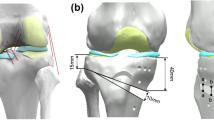Abstract
High tibial osteotomy (HTO) has been used to successfully treat patients with genu varus deformities that can improve mechanical function and condition in the knee joint. Clinical studies have reported that bow legs often occur with a concentrated load on the varus of the tibia. This study aimed to analyze and verify the clinical test data result by utilizing the three-dimensional (3D) static finite element method (FEM). The 3D model of lower extremities, which include the femur, tibia, meniscus, and knee articular cartilage, was created using the images from a computer tomography scan and magnetic resonance imaging. In this report, we compared changes in stress distribution and force reaction on the tibial plateau because of critical problems caused by unexpected changes in the tibial posterior-slope angle because of HTO. The results showed that the 5° wedge-angle virtual opening wedge HTO without and with the posterior-slope angle shows has a load concentration of approximately 60% and 45% in the medial region, respectively.
Similar content being viewed by others
References
H. R. Choi, Y. Hasegawa, S. Kondo, T. Shimizu, K. Ida and H. Iwata, High tibial osteotomy for varus gonarthrosis: a 10-to 24-year follow-up study, J. Orthop. Sci., 6 (6) (2001) 493–7.
M. B. Coventry, Osteotomy about the Knee for Degenerative and Rheumatoid Arthritis, Indications, operative technique, and results, J. Bone Joint Surg. Am., 55 (1) (1973) 23–48.
J. Insall, H. Shoji and V. Mayer, High tibial osteotomy. A five-year evaluation, J. Bone Joint Surg. Am., 56 (7) (1974) 1397–405.
T. R. Sprenger and J. F. Doerzbacher, Tibial osteotomy for the treatment of varus gonarthrosis, Survival and failure analysis to twenty-two years, J. Bone Joint Surg. Am., 85-a (3) (2003) 469–74.
S. H. Zaidi, A. G. Cobb and G. Bentley, Danger to the popliteal artery in high tibial osteotomy, J. Bone Joint Surg. Br., 77 (3) (1995) 384–6.
E. K. Song, High tibial osteotomy for osterarthritis of the knee.pdf, J. of Korean Orthop., 39 (1) (2004) 104–107.
T. W. Dugdale, F. R. Noyes and D. Styer, Preoperative planning for high tibial osteotomy, The effect of lateral tibiofemoral separation and tibiofemoral length, Clin. Orthop. Relat. Res., 274 (1992) 248–64.
W. Y. Matar, R. Boscariol and G. F. Dervin, Open wedge high tibial osteotomy: a roentgenographic comparison of a horizontal and an oblique osteotomy on patellar height and sagittal tibial slope, Am. J. Sports Med., 37 (4) (2009) 735–742.
F. R. Noyes, S. X. Goebel and J. West, Opening wedge tibial osteotomy: the 3-triangle method to correct axial alignment and tibial slope, Am. J. Sports Med., 33 (3) (2005) 378–87.
J. H. Wang, J. H. Bae, H. C. Lim, W. Y. Shon, C. W. Kim and J. W. Cho, Medial open wedge high tibial osteotomy: the effect of the cortical hinge on posterior tibial slope, Am. J. Sports Med., 37 (12) (2009) 2411–8.
S. B. Park, S. Y. Kim, J. H. Hyeong and K. R. Chung, A study on the development of image analysis instrument and estimation of mass, volume and center of gravity using CT image in Korean, Journal of Mechanical Science and Technology, 28 (3) (2014) 971–977.
R. W. Hsu, S. Himeno, M. B. Coventry and E. Y. Chao, Normal axial alignment of the lower extremity and loadbearing distribution at the knee, Clin. Orthop. Relat. Res., 255 (1990) 215–217.
A. Cilingir, V. Ucar and R. Kazan, Three-dimensional anatomic finite element modelling of hemi-arthroplasty of human hip joint, Trends Biomater Artif Organs, 21 (1) (2007) 63–72.
R. M. A. R. Izaham, M. R. A. Kadir, A. H. A. Rashid, M. G. Hossain and T. Kamarul, Finite element analysis of Puddu and Tomofix plate fixation for open wedge high tibial osteotomy, Injury, 43 (6) (2012) 898–902.
G. C. H. Bauer, J. Insall and T. Koshino, Tibial osteotomy in gonarthrosis (Osteo-Arthritis of the Knee), J. Bone Joint Surg. Am., 51 (1969) 1545–1563.
D. K. Bae, I. H. Jeon, B. J. Park and H. S. Yang, The relation between clinical results and correction angle in proximal tibial osteotomy, The Journal of Korean Knee Society, 11 (1) (1999) 82–89.
Author information
Authors and Affiliations
Corresponding author
Additional information
Recommended by Associate Editor Yoon Hyuk Kim
These authors equally contributed to the first authorship.
Jun-Woo Lee obtained his M.A. in Mechatronics Engineering from Chungnam National University. His research interests include structural health monitoring and static structural analysis.
Yuan-Zhu Xin received his B.S degree in Materials, Mechanical, and Automation Engineering from YanBian University of Science and Technology in 2009. He is currently pursuing his Ph.D. in the Department of Mechatronics Engineering at Chungnam National University. His research interest is the mechanics of the human body.
Jong-Hun, Ji received his M.D. from the Medical College of Chung Buk National University. Since 2002, he has been a professor at the Catholic University of Korea. His research interest is computational mechanics of the knee and shoulder joint.
Karnav Phanchal received his M.D. from the Medical College of the University. In 2014, he had a fellowship at Daejeon St. Mary’s Hospital of the Catholic University of Korea. His research interest is computational mechanics of the knee and shoulder joint.
Oh Soo Kwon, M.D. and Ph.D., is an attending knee surgeon in the Department of Orthopedic Surgery at Daejeon St. Mary’s Hospital of the Catholic University of Korea. He completed his fellowship at KyungHee University Hospital under Dr. D. K. Bae. He also completed a visiting program at the University of Pennsylvania.
Seak-Jo Yang received his Ph.D. in Biomedical Engineering from the University of Iowa. Since 2004, he has been a professor at Chungnam National University. His research interest is computational mechanics of the human body and vehicles.
Rights and permissions
About this article
Cite this article
Lee, JW., Xin, YZ., Ji, JH. et al. Stress analysis of the tibial plateau according to the difference of blade path entry in opening wedge high tibial osteotomy. J Mech Sci Technol 29, 1175–1179 (2015). https://doi.org/10.1007/s12206-015-0229-4
Received:
Revised:
Accepted:
Published:
Issue Date:
DOI: https://doi.org/10.1007/s12206-015-0229-4




